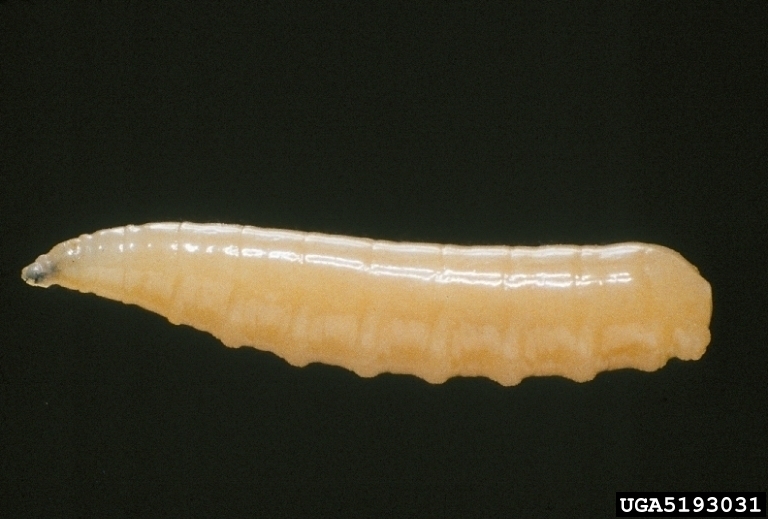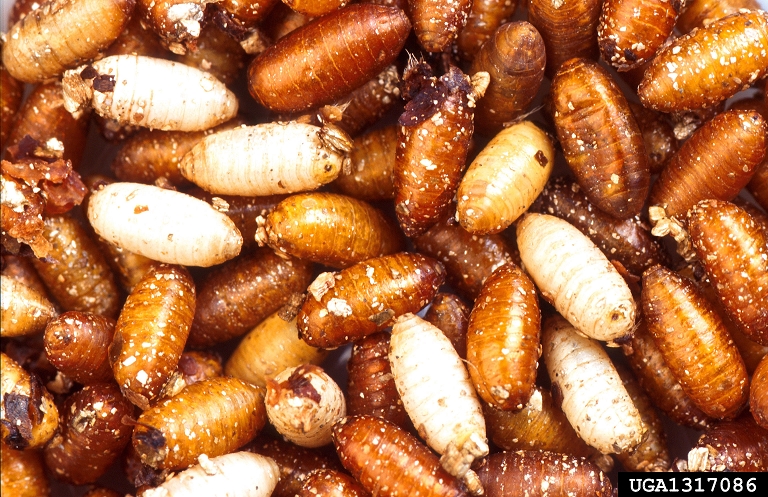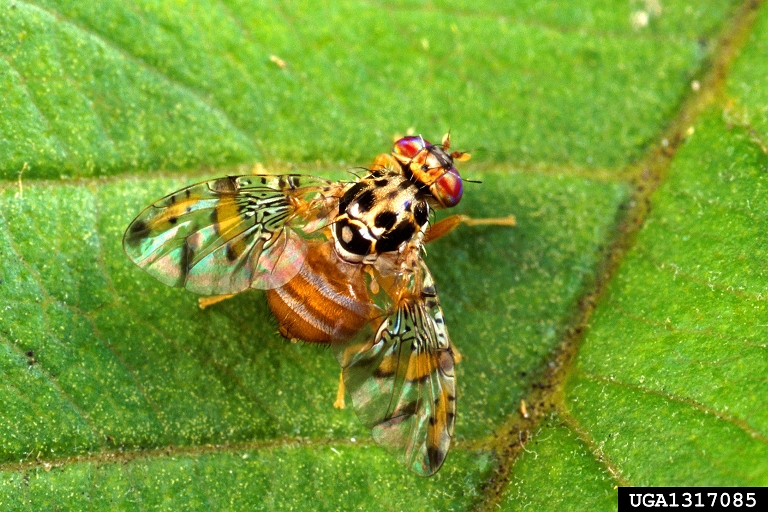Mediterranean fruit fly
Mediterranean fruit fly (Ceratitis capitata), or medfly, is a significant horticultural pest that is established in parts of Western Australia. There have been detections of medfly in South Australia. Outbreaks have been eradicated and South Australia undertakes activities to ensure medfly does not become established.
Anyone travelling to Victoria from South Australia and Western Australia is asked not to bring fruit or fruiting vegetables with them in an effort to keep medfly out of the state.
Medfly attacks a wide range of fruits and fruiting vegetables, decreasing production and making fruit inedible. This can have severe consequences for local and international trade.
Damage is caused by the female laying eggs in unripened or ripe fruit. The hatched larvae then eat the fruit from the inside, causing it to rot.
Description
Egg
Eggs (Figure 1) are laid in host fruit and are white in colour and banana-shaped. They are usually too small to see. Females pierce the skin of suitable host fruit and lay eggs inside. One to 30 eggs can be laid at one time.

Larvae (maggots)
Under ideal conditions, eggs hatch within two to three days. Newly hatched larvae are creamy white and 1 mm long (Figure 2). They feed on the flesh of the fruit while tunnelling inside. In warm conditions, larvae grow to 7 to 9 mm over one to two weeks. In colder weather, the larval stage can take up to 45 days.
Larvae have cutting jaws and feed on the fruit, causing it to rot from the inside. Infested fruit may appear in good condition from the outside. When fully grown, larvae leave the fruit, which by then has usually fallen to the ground. Larvae burrow into the soil to pupate.

Pupae
Pupae resemble small oval brown capsules and are about 4 mm long (Figure 3). Inside the pupa, the larva slowly develops into an adult. Pupae can survive tough conditions such as extreme temperatures. The pupal stage takes two weeks in summer and up to 50 days in colder conditions.

Adult
The adult medfly hatches and emerges from the ground early in the morning on warm days. Adults are 4 to 5 mm long and yellowish in colour. They have black markings on the body and distinctive brown bands on the wings (Figure 4).

Six to eight days after emerging from the pupae, females are ready to mate and search for suitable ripe fruit to lay their eggs inside. The punctures ('stings') made by laying females in the skin of fruits are very small and difficult to see.
Under favourable conditions, adult medfly can live for over six months but two to three months is usual. One female usually lays around 300 eggs during her lifetime, but numbers of up to 800 have been reported.
Feeding damage
Check the skin of your fruit and fruiting vegetables for sting marks, as this may indicate that eggs have been laid inside. Cut open fruit and fruiting vegetables to check for larvae inside (Figure 5).

Hosts
Medfly has a very wide host range, infesting the fruit of over 200 different plant species.
Economically important host species for Victoria include nectarines, peaches, table grapes, apples, pears and oranges.
For a list of medfly hosts, see the Mediterranean and Queensland Fruit Fly Host List.
Lifecycle
Medfly activity is dependent on temperature. In warmer months, one life cycle can take 28 to 34 days to complete, whereas in colder months, the life cycle can be extended to 115 days. Medfly can survive for extended periods as eggs or larvae in fruit and as pupae in the ground until the weather warms up.
Distribution and spread
Medfly is widespread in Africa and has spread to Europe, the Middle East, Central and South America, Hawaii and Western Australia.
Medfly spreads through the movement of larvae-infested host produce. Adult flies can also fly short distances locally.
Prevention and domestic quarantine
Victoria is free from medfly and has legislation and surveillance activities in place to assist in prevention, early detection and response activities. You can find the relevant conditions using the online Plant Quarantine Manual.
Medfly host material may enter Victoria if:
- It originates from an area covered by an area freedom certificate issued by an officer responsible for agriculture in the State or Territory; or
- It is accompanied by a Plant Health Certificate (PHC), Plant Health Assurance Certificate (PHAC), Plant Health Declaration or Permit, certifying or declaring that the material has been treated in a manner that meets Victoria’s importation requirements for Medfly;
and
Certification/declaration is forwarded to market.access@agriculture.vic.gov.au prior to dispatch.
The Victorian community can also assist in preventing an incursion of medfly by not travelling with fruit or fruiting vegetables when returning to Victoria from South Australia or Western Australia and by monitoring home gardens for medfly activity.
If medfly is found in Victoria, emergency response arrangements will be implemented to allow Agriculture Victoria to rapidly respond to the detection.
More information
Australian Interstate Quarantine
Photo credits
Figures 1 and 2: Florida Division of Plant Industry, Florida Department of Agriculture and Consumer Services, Bugwood.org
Figures 3 and 4: Scott Bauer, United States Department of Agriculture, Agricultural Research Service, Bugwood.org
Figure 5: Whitney Cranshaw, Colorado State University, Budwood.org
Reporting an unusual plant insect pest or disease
Report any unusual plant pest or disease immediately using our online reporting form or by calling the Exotic Plant Pest Hotline on 1800 084 881. Early reporting increases the chance of effective control and eradication.
Please take multiple good quality photos of the pests or damage to include in your report where possible, as this is essential for rapid pest and disease diagnosis and response.
Your report will be responded to by an experienced staff member, who may seek more information about the detection and explain next steps.
Report online